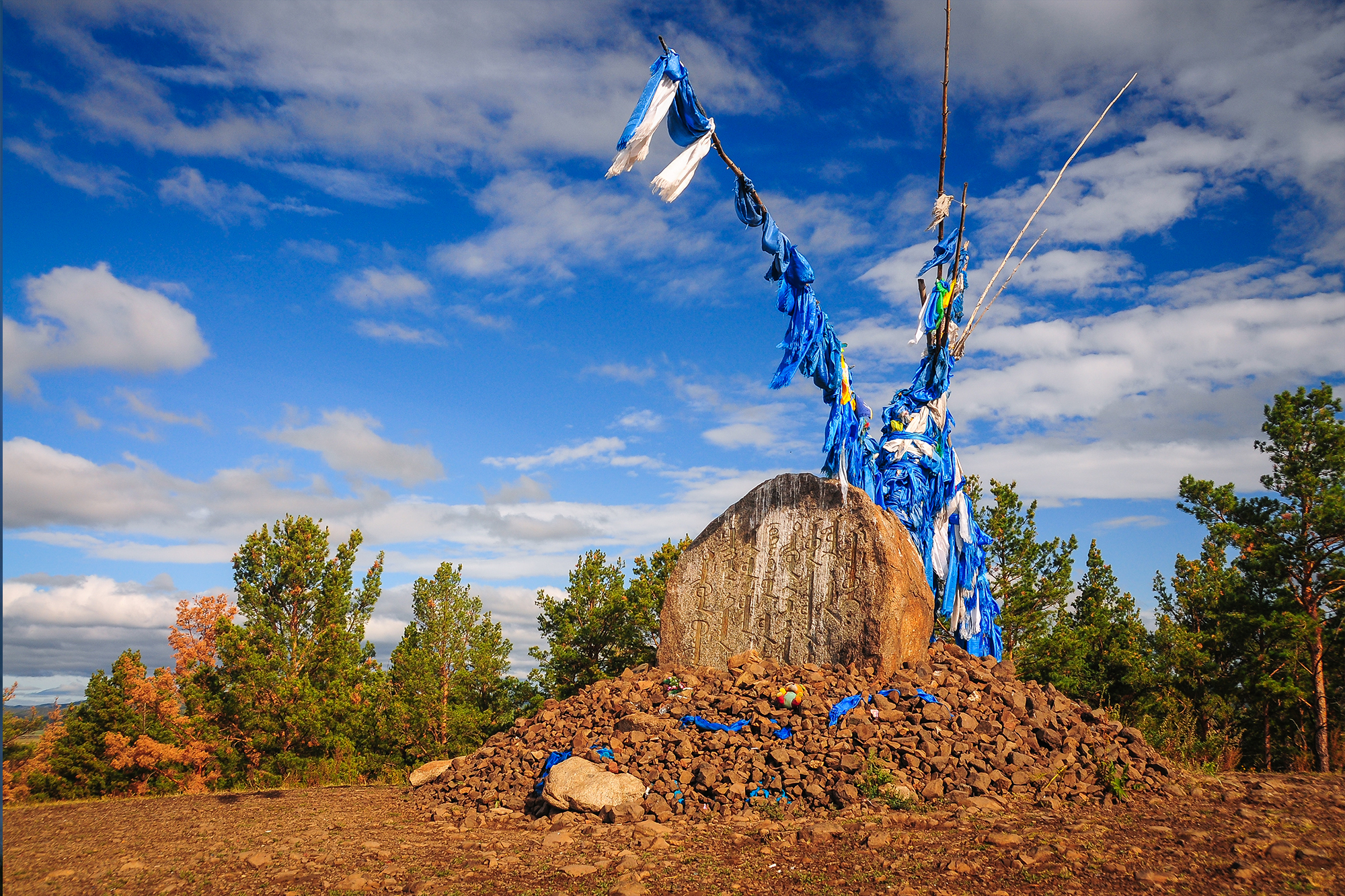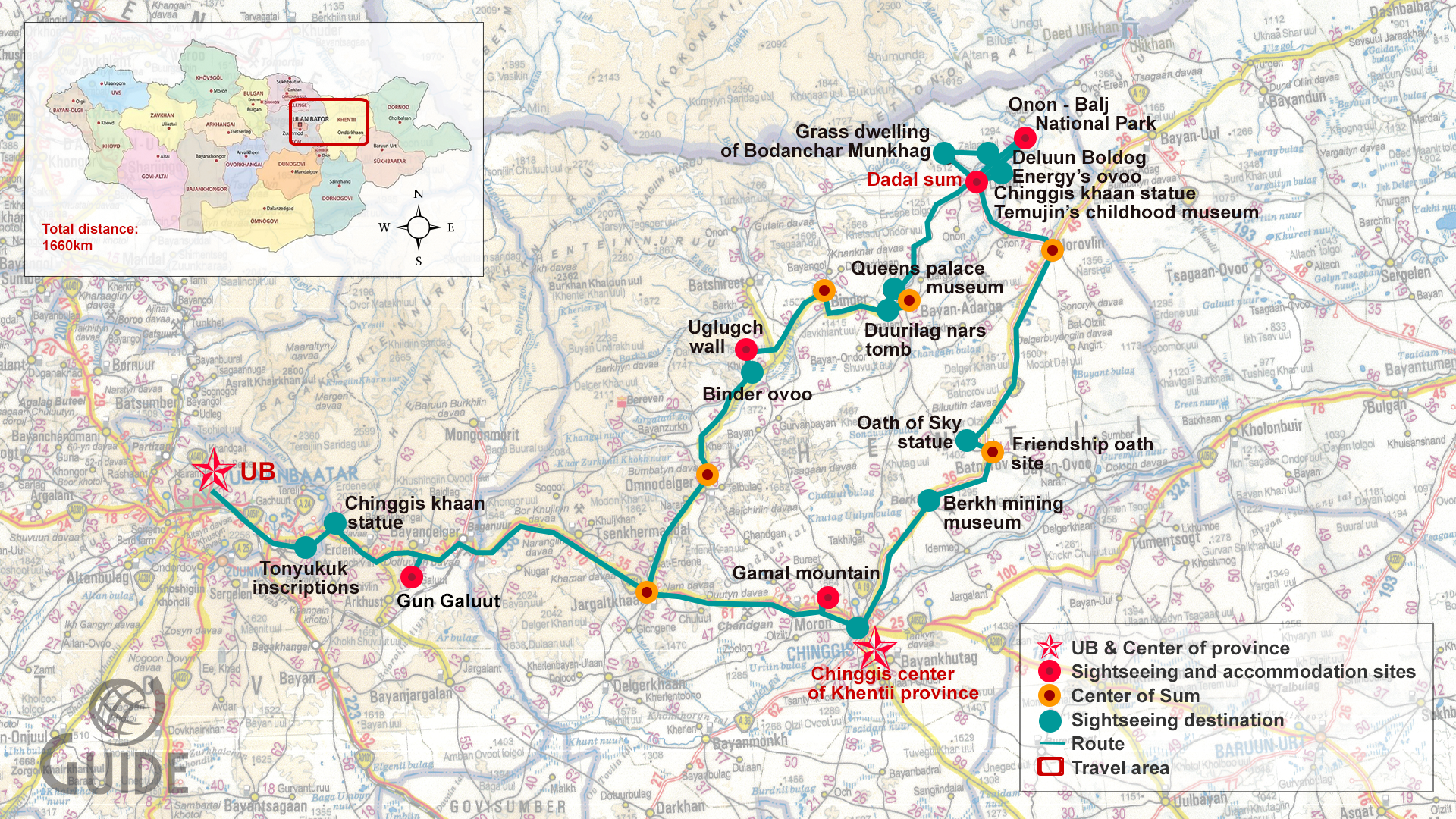Itinerary
DAY 1: Chinggis Khaan Airport – Ulaanbaatar (55 km)
Your tour starts with an arrival at Chinggis Khaan Airport at Khushig Valley. Depending on your arrival schedule, you’re offered to take a city tour, including Chinggis Khaan Museum and Sukhbaatar square. The day tour will be planned based on your arrival time.
Meal: Lunch, Dinner
Accommodation: Hotel
DAY 2: Tonyukuk inscriptions – Chinggis City (350 km)
This day, we visit the Tonyukuk inscriptions in Tuul river valley. This is a memorial complex consisting of the steles of Tonyukuk wise, who was the adviser to the last three successive khans (kings) of Turkic khaganate, dominated between 5th to 7th century in Central Asia. The inscriptions are about that Turk’s war stories, Tonyukuk’s praises, and words passed the to the next generation and the state of Turkic society at the time. Tonyukuk’s sacrificial shrine was built on the site after his death. Tonyukuk wise’s words still hold valuable and appreciative and they taught the people to be "peaceful, honest, well ordered, and not to be bribed" etc. And our next stop of the day is the Chinggis Khaan Equestrian Statue, the 40 meters massive monument. Besides the statue, you will also visit the "small-museum of history" in the basement of the building. Then, we arrive at Khentii Eco Tourist camp next to Mountain Gamal.
Meal: Breakfast, Lunch, Dinner
Accommodation: Tourist camp
DAY 3: Berkh Mining Museum - Batnorov – Dadal (310 km)
Early morning, we continue our tour by Berkh Mining Museum. Berkh mine is a place where field spar was mined, and now one of the depleted resources has been converted into Mongolia's first mining museum. Mongolia is the fifth largest producer and exporter of field spars in the world. Our next stop is the statue “Oath of Sky” in Batnorov sum. This statue was established based on the historical fact that is written in the “Mongolian Secret History” book. The story tells that at this site, Temuujin (Chinggis Khaan’s youth name) made a friendship with Boorchi who was one of the 9 powerful generals of his army. Temuujin lost his 8 yellow stallions and while searching for them he met Boorchi, who was the only son of wealthy man Nakhu, and Boorchi genuinely helped him to find back the stolen horses. Then they made a "friendship oath" at this place and this friendship lasted until the end of their life. Later, during the conquest of Chinggis Khaan, Boorchi became famous as one of his four knights. Before dinner, we reach Chinggis Khaan’s birthplace, Dadal sum.
Meal: Breakfast, Lunch, Dinner
Accommodation: Tourist camp
DAY 4: Statue of Chinggis Khaan – Energy mount – Bodanchar’s grass dwelling (70 km)
You will spend this day’s trip to the historical places of Chinggis Khaan and the origin of Mongols. You visit the small museum named “Temujin's childhood” in the village center. Then we pay tribute to a statue of Chinggis Khaan, which was secretly built during the Stalinism period and managed to survive. The stele statue was built in 1962 and is a 12-meter in height. Near the south of the statue, we see the historical place, the birthplace of Chinggis Khaan. An island collection of hills known as Deluun Boldog is located in one of three separate lakes called Gurvan Nuur (Three Lakes) and researchers generally accept that it is the birthplace of Chinggis Khaan. Now there is a stone mount in the place, and everyone who visits prays and worships as they meet with Chinggis Khaan. Mongolians have been worshiping that if the visitors pray sincerely, their spirits will be lifted and their work, life, and business will be flourished. Then, we visit the grass dwelling of Bodanchar Munkhag, a direct ancestor of Chinggis Khan, who bears the legend of Mongolian origins from the Borjigon tribe. This historical place tells the story of creating his tribe by hunting for a living with his domesticated hawks and falcons.
Meal: Breakfast, Lunch, Dinner
Accommodation: Tourist camp
DAY 5: Onon-Balj National Park – Buryat herder family (60 km)
This day, you will relax through the Onon-Balj National park’s gorgeous area of lakes, rivers, forests, and log huts, and admire the scenery. You visit the Khalkha and Buryat ethnic herder families and learn more about their customs and lifestyle, wear their traditional clothes, and take scenic photos. The Onon Balj National Park is the only place in Mongolia where mixed forests of pine, larch, and birch are distributed. This region is important for maintaining, regulating, and distributing water sources and moisture regimes of rivers. In 2000, 402,100 hectares of land covering were taken under state strict protection to protect a small amount of pine forest in the Onon-Balj National Park and to preserve nature and historical monuments in the area.
Meal: Breakfast, Lunch, Dinner
Accommodation: Tourist camp
DAY 6: Duurilag Nars Tomb – Uglugch Wall (200 km)
Early morning, we drive to Hunnu elite burials - Duurilag Nars tomb in Bayan-Adraga sum. The tomb complex has approximately 300 elite tombs of the Hunnu – the biggest Hunnu cemetery in Eastern Mongolia. The Hunnu Empire often buried specific ritual and sacrificial objects with their kings and aristocrats, especially 20 to 30 of his attendants and servants appear to have been sacrificed. Then you visit the "Mongolian Queens palace" museum. It is a place that honored 10 historical queens who have played important roles in Mongolian history. After lunch, we head to Binder sum. We arrive in a historical place where Chinggis Khaan united all Mongolian clans and established the “Great Mongol Empire” in 1206. Then we head to Uglugch Wall or Uglugchiin Kherem (literally “Almsgivers Wall”), which is 2.5-3 meters high, 2.5 meters wide, and approximately 3km long stone wall interrupted little in between. Researchers believe that the stone masonry represents early tribal boundaries. There is also a place where the nobles who belong to the golden ancestors (Altan Urag) of Chinggis Khan used to perform sacrifices known as “The place of nobles”. None of the gravesites of Chingghis Khan and his 36 successors have been found to the present day. The reason why the Mongols were able to keep the tombs of their kings and queens secret unrevealed until now. "The place of Nobles" refers to the place where made sacrifices and offers to the kings and ancestors from afar.
Meal: Breakfast, Lunch, Dinner
Accommodation: Tourist camp
DAY 7: Mount Binder – Umnudelger sum – Gun Galuut (260 km)
After breakfast, we arrive at Mount Binder. This is a historical place by the story told that on the site, ancestors of Mongols first arrived and offered sacrifices. The eastern vast places from this mount are connected deeply to Chinggis Khaan’s history. Then on the way back drive to Ulaanbaatar, we go alongside the 3 sums (village centers) and arrive at Gun Galuut tourist camp surrounded by amazing nature. On the east side of it, river Kherlen flows and small connected lakes encircled its northwestern. Its wetland environment provides a paradise for birds. As researchers found out that more than 100 species of birds come here.
Meal: Breakfast, Lunch, Dinner
Accommodation: Tourist camp
DAY 8: Gun Galuut – Ulaanbaatar 140 km
After breakfast, we drive back to Ulaanbaatar. You will take a city tour, see Gandantegchilen Monastery and stop by shopping centers. The statue of Megjid Janraisig, a 26-meter-high majestic gilded indoor statue, was made with a sample of everything that Mongolians worship and value. Rather than a statue of God, it can be understood as a collection of all the virtues of Mongolians. You may also shop for good cashmere Gobi brand which is one of the Mongolian national brand products. After the city tour and shopping, you will take have dinner and spend a relaxing evening at the hotel.
Meal: Breakfast, Lunch, Dinner
Accommodation: Hotel
DAY 9: Shaman center (35 km)
On this day, you will get to know more about shamanism. We visit the shaman museum and meet a shaman to get acquainted with the ritual of communicating with the spirits of ancestors. Shamanism is a form of worship that has been carried in the mentality of Mongolians since ancient times and was intricately tied to all aspects of social life and the tribal organization of Mongolian society. Shamanism is one of the oldest forms of religion and shamanic practices may originate as early as the Paleolithic, and certainly as early as the Neolithic period from the primitive society tribes before they transitioned to a class society in the 3rd century BC. In other words, it is a primitive form of worship, a belief in the spirits of ancestors, the owners of heaven and earth. The kings of the Mongolian first state Hunnu to Xianbei, Rouran, Turk, Uyghur, and Kitan worshipped shamanism. Later in the 13th century, during the Great Mongol Empire of Chingghis Khan, shamanism had a strong place in state policy. From ordinary households to royal palaces, shaman idols were placed in the most respected places.
Meal: Breakfast, Lunch, Dinner
Accommodation: Hotel
DAY 10: UB - Chinggis Khaan Airport (55 km)
We transfer you to the airport according to your departure time from Chinggis Khaan International Airport.
Meal: Breakfast






